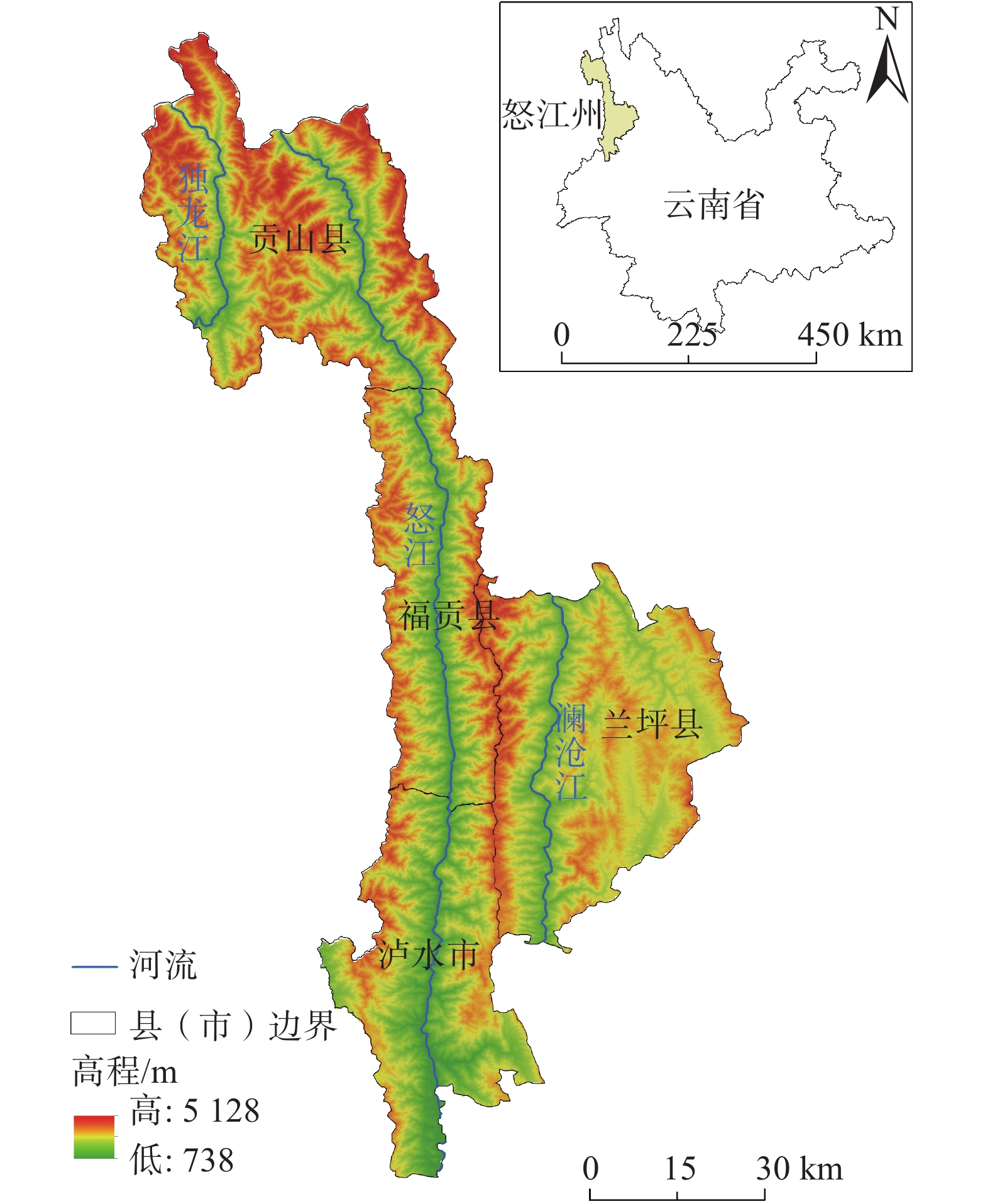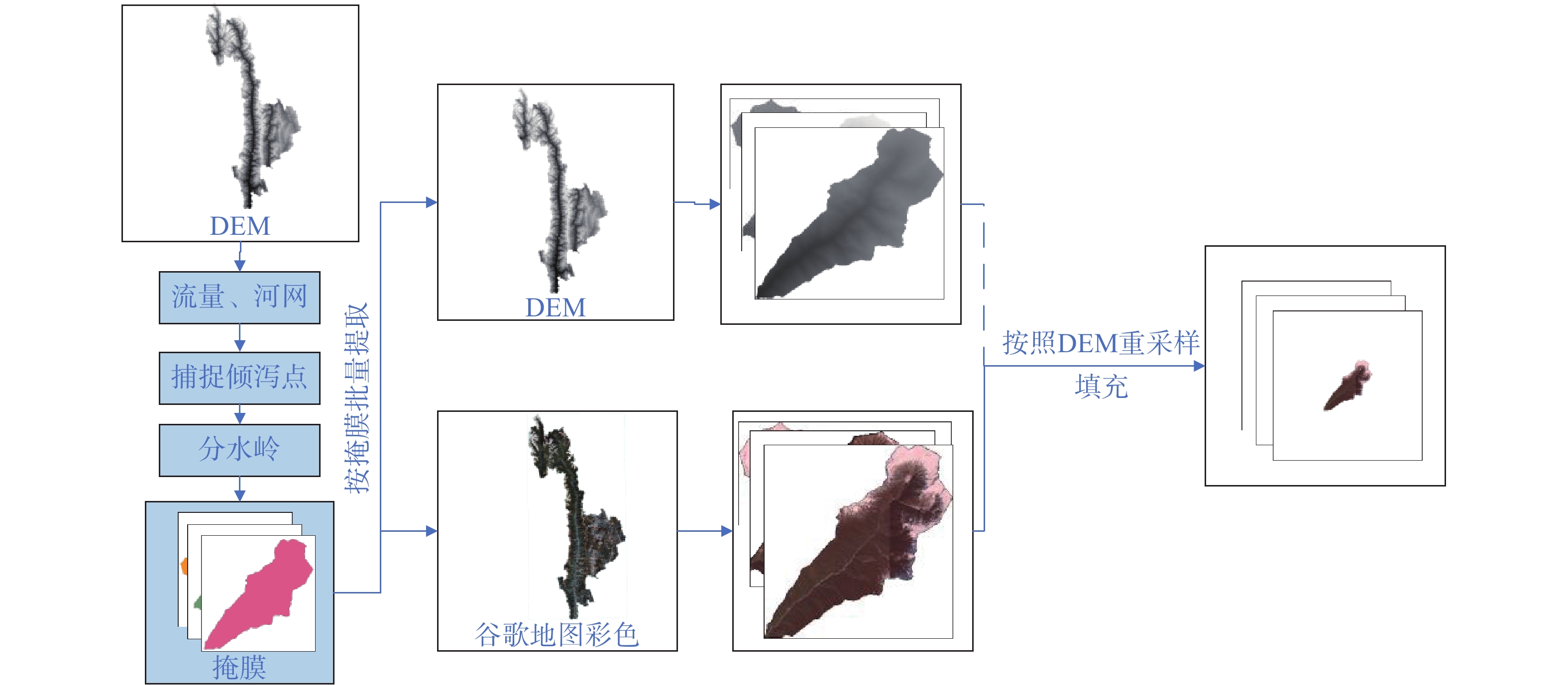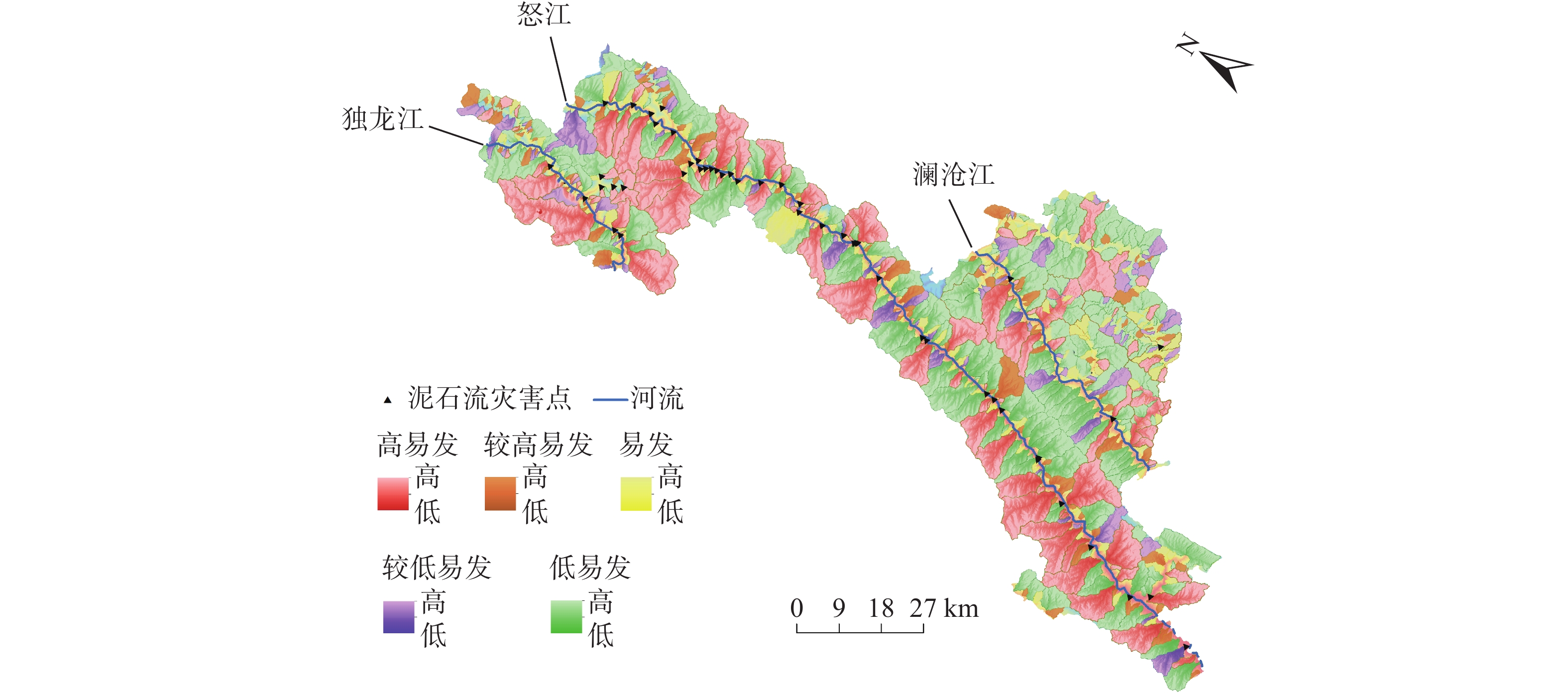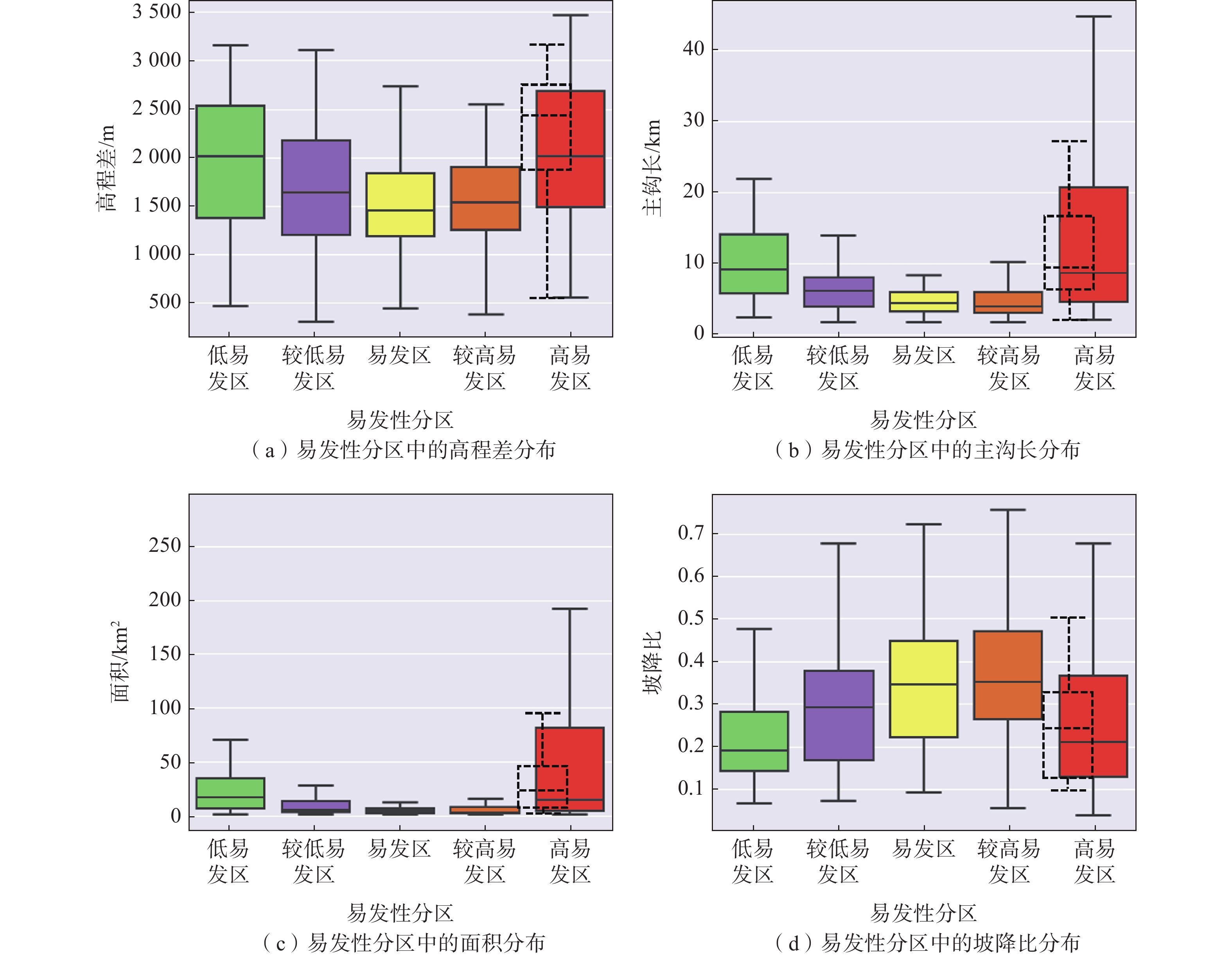A case study on the susceptibility assessment of debris flows disasters based on prototype network in Nujiang Prefecture, Yunnan Province
-
摘要: 针对基于泥石流因子评价方法中选取因子不一及训练样本少的问题,提出了一种基于原型网络的沟谷泥石流灾害易发性评价方法。首先,通过元学习方式组织训练数据,计算每一类沟谷的原型中心。其次,计算未知样本与每一类原型中心的距离,得到其从属类别的概率。最后,根据类别概率计算沟谷的泥石流易发性指数,得到泥石流易发性评价等级。运用模型对怒江州的沟谷进行评价,并与历史灾害数据进行比对,分类正确率达到67.39%,历史事件中泥石流灾害严重程度与模型的评价等级吻合度较好。相比传统实地勘测和因子评价等方法,文章方法能够通过遥感影像进行泥石流灾害区域的快速识别与评价,为泥石流灾害的预警预测研究带来新的思路。Abstract: In response to the issues of inconsistent factor selection and limited training samples in debris flow factor-based evaluation methods, this study proposed a prototypical network-based approach for assessing the susceptibility of valley debris flow disasters. The method involves organizing the training data through meta-learning and calculating the prototype center for each valley type, serving as a representative of that category. Subsequently, the distance between the features of unknown samples and the prototype center of each class is computed to determine the probability of their classification. Based on the category probabilities, the debris flow susceptibility index of the valley is calculated to obtain the evaluation grade for debris flow susceptibility. The model was applied to evaluate the valleys in Nujiang Prefecture, and its results were compared with historical disaster data, yielding a classification accuracy rate of 67.39%. The evaluation levels provided by the model align well with the severity of debris flow disasters in historical events. Compared to traditional methods such as field surveys and factor evaluation, the method proposed in this paper allows for the rapid identification and evaluation of debris flow disaster areas using remote sensing imagery, presenting new insights for research on early warning and prediction of debris flow disasters.
-
0. 引言
确定岩石中不同组分的实际分布,是分析岩石物理力学性质的重要基础,对分析岩石变形破坏过程具有重要意义。对于一幅岩石图像来说,确定不同组分分布的核心是确定不同位置组分的类别,本质上是对岩石图像进行图像分割处理。目前,图像分割的常规方法是阈值分割法和聚类法,利用图像中不同组分的颜色、轮廓、纹理等特征来确定类别。但使用常规图像分割方法确定组分类别,效果往往不能令人满意。
使用图像分割的方法确定岩石中不同组分的类别已经进行了很多研究。徐永进等[1]根据CT图像中相邻图像的直方图相似性来确定岩石中不同组分的分割阈值;张嘉凡等[2]基于相似性度量标准的改进聚类分析,对岩石CT图像进行了图像分割和损伤量化分析;钱庆波等[3]使用点选法和阈值分割技术,得到花岗岩中不同组分的分布情况;朱赛楠等[4]使用迭代最佳阈值算法提取了岩石CT图像中的损伤区域;刘春等[5]使用改进种子算法分割岩石图像中的颗粒和孔隙,研究了岩石中微观颗粒与孔隙形状复杂度的变化;简文星等[6]编写了利用Sobel算子进行边缘检测、进而对岩石图像中不同组分进行阈值分割的岩石裂隙检测系统。
近年来,随着人工智能技术的发展,使用深度学习确定物体中不同组分分布的研究取得了很多进展。与传统图像识别方法相比,使用深度学习算法进行图像分割的精确度更高,可以将比较复杂的目标识别出来。KRIZHEVSKY等[7]使用ReLU算法作为激活函数的激活层和防止模型过拟合的Dropout层,设计了经典卷积神经网络AlexNet,促进了深度学习算法的应用;SIMONYAN和ZISSERMAN[8]建立了VGGNet网络,分析了卷积神经网络(CNN)中网络深度和网络性能之间的关系;GIRSHICK等[9-13]通过在感兴趣区域上单独进行卷积网络评估和边框目标检测的方法,构建了区域卷积网络R-CNN(Region-based CNN),并在几次改进之后得到了Mask R-CNN网络;BADRINARAYANAN等[14]使用编码层、解码层和像素分类层建立了SegNet图像分割网络;LONG等[15]提出了端到端、像素到像素的全卷积神经网络(Fully convolutional networks,FCN),可以有效解决图像中不同组分类型的确定问题。
在农业、生物和医学等领域,使用全卷积神经网络进行图像分割也取得了一些成果。王振等[16]通过改进全卷积神经网络中的激活函数和分类器,改善了黄瓜叶部病斑的图像分割效果;黄英来等[17]采用基于跳跃连接的全卷积神经网络分割技术,进行林木图像的图像分割;RONNEBERGER等[18]使用具有数据增强功能的全卷积神经网络,对细胞图像中的神经元结构进行图像分割;黄龙等[19]利用层间融合方法,构建了用于室内场景分割的全卷积神经网络;郑婷月等[20]利用多尺度特征融合技术来改进全卷积神经网络,进行了视网膜血管的图像分割研究。
虽然深度学习方法取得了很多进展,在不同领域应用也获得了丰硕成果,但是将深度学习方法用于确定岩石中不同组分的位置与类别,目前研究成果还不多。本文拟以花岗岩为例,根据抽取岩石单轴压缩试验视频中的单帧图像,在建立不同组分数据集的基础上,使用全卷积神经网络(FCN)确定图像中任意位置的组分类别,进而使用试验视频分析不同组分分布及其识别准确率随时间的变化情况;探讨网络深度、初始学习率和网络迭代次数等参数对识别正确性的影响。
1. 岩石中不同组分的识别
1.1 数据集的建立
试验所用岩石为花岗岩,相应岩块取自甘肃省玉门市北山地区。将岩块切割并磨光制成100 mm × 50 mm × 50 mm的标准试块,采用单轴压缩试验机对试块进行加载,试验时同时拍摄视频。
为了减小后续计算量,在试块变形破坏过程的280 s内每隔1 s选取一帧图像,总共得到280张图像。将所有单帧图像转换成灰度图像并裁剪成238 px × 238 px,每个像素实际宽度为0.17 mm/px,如图1所示。
根据岩石中不同组分的形态和颜色特征,使用肉眼判定方法来识别岩石中4种不同组分的类型,将不同组分的实际分布标记出来,制成标签数据集。数据集中的标签分为4类,对应花岗岩中裂隙、黑云母、石英、长石4种细观组分,如图2所示。图2中,白色像素为不同组分的实际位置,黑色像素为背景。
1.2 全卷积神经网络的建立
普通卷积神经网络(CNN)结构由卷积层、池化层、激活层和全连接层(Fully connected layer)等组成。花岗岩图像经过一系列卷积、池化和激活操作,进入有分类器作用的全连接层后会丢失空间坐标,只能得到图像中不同组分类别的概率[21]。比如,取花岗岩图像右上角一部分区域输入CNN网络中进行识别,只得到图像中黑色色块为黑云母组分的概率,但无法识别周围灰色和白色部分的组分类别、也无法得到不同组分的具体位置信息,如图3(a)所示。
全卷积神经网络(FCN)将普通卷积神经网络(CNN)中的全连接层修改成卷积核为1×1的全卷积层(Fully convolutional layer),使用像素类型分类层将每个像素点映射到不同组分的分类,进而对每一个像素点进行分类,并保留像素的空间坐标信息[15]。利用所建全卷积神经网络对花岗岩图像中4种组分进行识别,得到不同组分的实际分布情况,如图3(b)所示。
本文建立的全卷积神经网络包含5个网络模块,分别是:输入层、下采样模块(Downsampling)、上采样模块(Upsampling)、像素类型分类模块和输出层,如图4所示。
图4中,图像输入层定义了网络训练时输入的图像大小及图像颜色通道数,输入的图像是前述得到的数据集。研究时,将数据集分为训练集和测试集,4种组分的训练集图像均为200组,测试集图像均为80组。
下采样模块的功能是不断缩小图像并提取图像中各组分的特征,该模块包括5个卷积层(Convolutional layer)、5个ReLU层(Rectified Linear Unit,线性整流函数)和2个最大池化层(Max pooling layer)。其中,卷积层的目的是压缩图像大小,提取不同组分的颜色、几何、位置等信息;ReLU层的目的是增加稀疏性、激活一部分神经元;最大池化的目的是压缩图像大小,减少计算的复杂度,提取图像中不同组分的主要特征。上采样模块的功能是提取各组分特征后将图像还原回原来的大小,该模块包括2个转置卷积层(Transposed convolution layer)和2个ReLU层,转置卷积层是卷积过程的转置操作,能够按照像素的颜色和位置信息将图像还原回原来的尺寸。像素类型分类模块包括1个全卷积层、1个Softmax层和1个像素分类层。Softmax层是对全卷积后的图像进行归一化处理,像素分类层则进行像素类别的确定。
1.3 网络训练的主要参数
为了防止网络调整速度过慢、出现过拟合的情况,将初始学习率设置为0.008;为了提高网络训练效率,将训练集中标签图像分成4个批次、网络训练周期设为100。所建全卷积神经网络中各层参数如表1所示。
表 1 全卷积神经网络的各层参数Table 1. Parameters used in FCN层序 名称 -2603519748500卷积核 步长 边缘填充像素 数量 大小 1 图像输入层 238×238×1 2 卷积层1 64 3×3 [1 1] [1 1 1 1] 3 ReLU层1 — 4 最大池化层1 1 2×2 [2 2] [0 0 0 0] 5 卷积层2 64 3×3 [1 1] [1 1 1 1] 6 ReLU层2 — 7 卷积层3 64 3×3 [1 1] [1 1 1 1] 8 ReLU层3 — 9 卷积层4 64 3×3 [1 1] [1 1 1 1] 10 ReLU层4 — 11 卷积层5 64 3×3 [1 1] [1 1 1 1] 12 ReLU层5 — 13 最大池化层5 1 2×2 [2 2] [0 0 0 0] 14 转置卷积层1 64 4×4 [2 2] [-1-1-1-1] 15 ReLU层1_1 — 16 转置卷积层2 64 4×4 [2 2] [0 0 0 0] 17 ReLU层2_1 — 18 全卷积层 4 1×1 [1 1] [0 0 0 0] 19 Softmax层 — 20 像素分类层 — 21 图像输出层 238×238×1 1.4 全卷积神经网络的训练
1.4.1 输入数据集
将标记好的标签图像数据集输入到全卷积神经网络中进行训练,让网络自行学习数据集中不同组分标签的特征属性。经过反复迭代调整后,得到用于花岗岩不同组分识别的FCN网络。
1.4.2 不同组分的可视化特征
全卷积神经网络训练完成之后根据网络各层结构,将各卷积层、转置卷积层和全卷积层按照网络的搭建顺序进行可视化处理,研究不同卷积核“学习”到的特征,如图5所示。
由图5可以看出,第1个卷积层(cov1)将不同组分的颜色信息提取了出来;第2个卷积层(cov2)能够初步识别不同组分的轮廓、颗粒大小等形状特征;随着卷积层深度的加大,不同组分形态特征和颜色特征不断被抽象化;第5个卷积层(conv5)已经基本再现了不同组分的形状特征和颜色特征;再经过两层转置卷积层(Trans1和Trans2),图像的局部信息被逐渐恢复;通过全卷积层、Softmax层和像素分类层,最终识别了花岗岩图像中的不同组分类别。
全卷积神经网络的组分识别结果可能存在少量误差。将输出图像和原图像对比可知,就裂隙和黑云母而言,裂隙右侧有极少量黑云母组分被识别成裂隙,中间区域顶部和底部有一部分裂隙被识别成黑云母组分;就石英和长石来说,两种组分交界处界限不是很明显、交界处识别出现了一些误差,例如左上角区域石英被识别成长石,中部区域裂隙周围长石被识别成石英。但总体而言,全卷积神经网络有很强的图像分割能力,岩石中大部分位置的组分被很好地识别出来。
2. 不同组分分布随时间的变化
观察花岗岩从开始变形到完全破坏的整个过程,可以将外荷作用下花岗岩的变形破坏过程分为A、B、C三个阶段:0~58 s的阶段A为变形阶段,岩石表面微观裂隙逐渐发展为宏观裂隙;59~197 s的阶段B为渐进破坏阶段,宏观裂隙宽度和长度持续增大;198~280 s的阶段C为完全破坏阶段,宏观裂隙长度达到最大、宽度持续增加。
利用训练好的全卷积神经网络对变形破坏过程时图像中不同组分进行识别,得到不同组分分布随时间的变化情况,如图6所示。
由图6可以看出,在变形阶段,裂隙首先出现在岩样中间偏上部的位置然后向上下两端延伸,在50 s时岩样中间偏下位置出现第2条裂隙并不断向中间和底部延伸。黑云母的面积较小,呈现为分散的点状分布,位移不明显。石英呈现为均匀的块状分布,相互之间连结紧密,中间石英向左右两侧移动。长石主要以片状集中分布在左上角区域,部分以点状和块状分散在其他区域,中间部分向左右两侧轻微移动。
在渐进破坏阶段,开始时第1条裂隙向上延伸于接近岩样顶端,向下与第2条裂隙几乎相连,然后上下两条裂隙连通,纵向贯穿于岩石表面并将岩石分为左右两个区域,且裂隙宽度不断增大;黑云母在岩样左侧时往左上移动,在右侧时往右上移动;石英在岩样中间时被大量压裂,没有被压裂的则向两侧移动;长石在岩样中间也被大量压裂,周围长石向两侧大幅移动。
在完全破坏阶段,裂隙宽度持续增大并没有迅速出现新生裂隙;黑云母基本分散出现在岩样中间区域,位移持续增大;石英基本分布在岩样两侧区域,位移也逐步增大;长石在岩样左上角区域增多,持续向左右两侧移动。
由上可知,在花岗岩整个变形破坏过程中,裂隙在中部区域萌生,最后纵向贯穿了整个岩石表面。黑云母组分分布比较分散且不断向左上方或右上方移动。石英集中分布在两侧区域,长石集中分布于岩样中间区域和左上角区域。石英和长石在岩样中间区域均遭受破坏且多向左右两侧移动。
3. 全卷积神经网络识别效果分析
3.1 评估指标
研究时,本文使用两个定量指标来评价所建全卷积神经网络对岩石单帧图像中不同组分的识别效果。这两个指标是:
(1)准确率(Accuracy),即某一组分类别正确分类的像素数量与标签上该类别像素数量之比;
(2)全局准确率(Global Accuracy, GA),即所有组分类别正确分类的像素数量与图像总像素数量的比值,计算公式如下:
(1) 式中,CN、QN、FN、BN分别为对裂隙、黑云母、石英、长石进行正确分类的像素数,TN为图像总像素数。GA的变化范围是[0, 1]。GA越大,识别效果越好。
3.2 不同组分识别准确率随时间的变化
使用准确率作为评估参数,利用已经训练好的全卷积神经网络对变形破坏过程中岩石中的不同组分进行识别,得到识别准确率随时间的变化情况,如图7所示。
由图7可知,裂隙识别的准确率为98%左右,但在60 s左右时有小幅降低;黑云母识别的准确率为95%左右,在60,150,200 s左右时有小幅下降;长石识别的准确率为83%左右但波动较大,在60 s左右时明显下降,70 s左右时为85%左右,200 s后下降较大;石英识别的准确率为75%~80%波动,60 s左右明显下降,70 s左右时为80%左右,200 s后下降幅度较大。
由此可知,花岗岩中不同组分识别准确率大小顺序是:裂隙>黑云母>长石>石英。加压至60 s左右时岩石从变形阶段转到破坏阶段,各组分识别的准确率均会下降;200 s后岩石完全破坏,岩石中黑云母、长石和石英这三种基本组分识别的准确率不断降低。
3.3 网络参数影响分析
将网络深度、初始学习率和网络迭代次数作为影响因素,使用全局准确率来评估因素所建FCN识别效果的影响。FCN的网络深度取3个,分别是17层(拥有3个卷积层和5个ReLU层)、19层(拥有4个卷积层和6个ReLU层)、21层(拥有5个卷积层和7个ReLU层);初始学习率r分别取0.001、0.002、0.004、0.006、0.008;网络迭代次数分别取2600、5000、6600。不同因素下所建FCN识别效果的计算结果如表2所示。
表 2 所建FCN的全局准确率计算结果Table 2. Global Accuracies of established FCN网络深度 网络迭代次数 初始学习率r 0.001 0.002 0.004 0.006 0.008 17层 2600 0.847 0.848 0.855 0.863 0.871 5000 0.849 0.854 0.873 0.864 0.887 6600 0.851 0.855 0.857 0.864 0.874 19层 2600 0.849 0.857 0.864 0.866 0.874 5000 0.851 0.863 0.884 0.878 0.894 6600 0.854 0.861 0.874 0.869 0.877 21层 2600 0.848 0.860 0.874 0.881 0.875 5000 0.847 0.866 0.891 0.896 0.900 6600 0.855 0.875 0.882 0.880 0.883 由表2可以看出,网络深度越深,FCN的识别效果越好;初始学习率越大,FCN的识别效果越好;5000次迭代的识别效果最好。
4. 结 论
本文使用全卷积神经网络和单轴压缩试验视频,研究了单轴压缩条件下花岗岩变形破坏过程中不同组分分布与网络识别准确率随时间的变化特征,分析了网络深度、初始学习率和迭代次数对岩石中不同组分识别正确性的影响,结果表明:
(1)在单轴压缩条件下,花岗岩首先在试样中部区域萌生裂隙、最后该裂隙纵向贯穿岩石表面,黑云母组分分布分散且不断向试样左上或右上移动,石英和长石大多向试样左右两侧移动;
(2)全卷积神经网络对花岗岩中不同组分识别准确率的大小顺序是:裂隙>黑云母>长石>石英,岩石从变形阶段转到破坏阶段时各组分识别准确率出现小幅下降,岩石完全破坏时各分识别准确率迅速降低;
(3)对于所建全卷积神经网络来说,网络深度越深、初始学习率越大、则识别效果越好,迭代次数5000时的识别效果较好。
-
表 1 Google Earth遥感和DEM数据信息
Table 1 Information on Google Earth remote sensing and DEM data
数据信息 Google Earth DEM 数据来源 Google Earth软件 地理空间数据云
http://www.gscloud.cn/home数据类型 遥感图像 数字高程模型 空间分辨率 2~15 m
按照DEM采样为30 mASTER GDEM V2
垂直精度20m,水平精度30m通道数 3 1 时相 泥石流沟谷/与发生时间后最近时间分辨率影像图像
负样本及评测沟谷/最新遥感图像2015年1月6日发布的ASTER GDEM V2版本 表 2 多个特征提取器的分类性能
Table 2 Classification performance of multiple feature extractors
特征提取器 6分类/% 2分类/% VGG 55.43 59.78 GoogleNet 51.09 56.52 ShuffleNetV2 47.82 51.09 MobileNetV2 53.26 55.43 ResNet12 40.22 44.57 ResNet18 44.57 48.91 DenseNet 50.00 64.13 Rir 51.08 57.61 Conv4 58.70 67.39 表 3 6分类测试混淆矩阵
Table 3 Confusion matrix of six-classification
6分类混淆矩阵 预测值 0 1 2 3 4 5 真实值 0 9 2 0 2 1 0 1 0 10 1 0 2 6 2 0 2 12 0 0 3 3 2 2 0 9 0 0 4 0 8 0 0 5 2 5 0 0 4 0 1 9 表 4 正负2分类测试混淆矩阵
Table 4 Confusion matrix for positive and negative binary-classification test
2分类混淆矩阵 预测值 正样本 负样本 真实值 正样本 36 14 负样本 16 26 表 5 2分类和6分类指标表
Table 5 Binary-classification and six-classification indicator table
Accuracy/% Precision/% Recall/% F1 Score Kappa 67.39 69.23 72.00 0.71 0.50 表 6 4条泥石流沟谷原型网络计算的所属概率和易发性指数
Table 6 Probability and susceptibility index of four debris flow valleys with prototype networks
沟谷流域 编号 所属概率 易发性指数 0 1 2 3 4 5 普拉底乡东月谷 A 0.000 4 0.966 3 0.002 7 0 0.014 5 0.016 2 0.966 3 普拉底乡咪谷河 B 0.000 7 0.999 3 0 0 0 0 0.999 3 独龙江乡巴坡村沟谷 C 0.863 4 0.105 7 0.006 2 0.001 9 0.009 4 0.013 3 0.863 4 金顶镇七联村练登大沟 D 0.315 3 0.504 2 0.002 4 0.060 3 0.113 9 0.003 9 0.504 2 表 7 4条泥石流沟谷因子分析方法计算的所属概率和易发性指数
Table 7 Probability and susceptibility index of four debris flow valleys with factor analysis methods
沟谷流域 编号 所属概率 易发性指数 0 1 2 3 4 5 普拉底乡东月谷 A 0 0.08 0.79 0 0.01 0.12 0.79 普拉底乡咪谷河 B 0.53 0 0.04 0.41 0.02 0 0.53 独龙江乡巴坡村沟谷 C 0.31 0 0 0.69 0 0 −0.69 金顶镇七联村练登大沟 D 0.68 0.02 0.04 0.11 0.13 0.02 0.68 表 8 4条泥石流沟谷的地貌条件和物质条件因子分析
Table 8 Factors analysis of geomorphological and material conditions of four debris flow valleys
地貌条件和
物源条件泥石流沟谷 东月谷 咪谷河 巴坡村沟谷 练登大沟 主沟长度/km 16.52 14.70 2.45 10.30 面积/km2 45.90 47.22 1.10 16.26 高程差/m 2 854 2 548 1 244 1 386 坡降比 0.17 0.17 0.51 0.13 平均坡度/(°) 15.46 26.49 33.64 16.17 Melton指数 0.42 0.37 1.18 0.34 植被覆盖[35] 有林地41.66%
灌木林10.42%
疏林地31.25%
中覆盖度草地16.67%有林地55.55%
灌木林8.88%
疏林地15.52%
中覆盖度草地5.03%
低覆盖度草地15.02%有林地50.00%
灌木林50.00%疏林地47.06%
高覆盖度草地47.06%
其它建设用地5.88%土壤性质[36] 松软薄层土
简育高活性淋溶土松软薄层土
简育高活性淋溶土简育高活性强酸土
简育高活性淋溶土不饱和雏形土
简育高活性淋溶土地层岩性[36] 花岗岩、板岩、千枚岩、片岩 花岗岩、板岩、千枚岩、片岩 花岗岩、石灰岩和其他碳酸盐岩 板岩、千枚岩、杂砂岩、长石砂岩、砂岩
石灰岩和其他碳酸盐岩 -
[1] 唐邦兴,杜榕桓,康志成,等. 我国泥石流研究[J]. 地理学报,1980(3):259 − 264. [TANG Bangxing,DU Rongheng,KANG Zhicheng,et al. Study on debris flow in China[J]. Acta Geographica Sinica,1980(3):259 − 264. (in Chinese) TANG Bangxing, DU Rongheng, KANG Zhicheng, et al. Study on debris flow in China[J]. Acta Geographica Sinica, 1980(03): 259-264. (in Chinese)
[2] 唐邦兴,柳素清,刘世建. 我国山地灾害的研究[J]. 山地研究,1984(1):1 − 7. [TANG Bangxing,LIU Suqing,LIU Shijian. Study on mount ain cal amities in CHINA[J]. Mountain Research,1984(1):1 − 7. (in Chinese with English abstract) TANG Bangxing, LIU Suqing, LIU Shijian. Study on mount ain cal amities in CHINA[J]. Mountain Research, 1984(01): 1-7. (in Chinese with English abstract)
[3] 陈宁生, 杨成林, 李战鲁, 等. 汶川地震次生泥石流形成发展趋势与防治对策[C]//汶川大地震工程震害调查分析与研究, 2009: 315 − 321 CHEN Ningsheng, YANG Chenglin, LI Zhanlu, et al. Formation and development trend of debris flow induced by Wenchuan earthquake and countermeasures[C]//Analysis and Investigation on Seismic Damages of Projects Subjected to Wenchuan Earthquake, 2009: 315 − 321. (in Chinese)
[4] 陈宁生,谢万银,李战鲁. 中国西南山区的泥石流分区与预测[J]. 高原气象,2004(增刊 1):134 − 140. [CHEN Ningsheng,XIE Wangyin,LI Zhanlu. Division and prediction of debris flow in mountain area of south west China[J]. Plateau Meteorology,2004(Sup 1):134 − 140. (in Chinese with English abstract) CHEN Ningsheng, XIE Wangyin, LI Zhanlu. Division and prediction of debris flow in mountain area of south west China[J]. Plateau Meteorology, 2004(S1): 134-140. (in Chinese with English abstract)
[5] 陈宁生,胡桂胜. 天山天池景区地质灾害防治与生态环境保护关键技术研究及应用[J]. 科技促进发展,2015(3):380 − 384. [CHEN Ningsheng,HU Guisheng. Research and application on Tianshan Tianchi scenic geological disaster prevention and environment protection key technology[J]. Science & Technology for Development,2015(3):380 − 384. (in Chinese with English abstract) CHEN Ningsheng, HU Guisheng. Research and application on Tianshan Tianchi scenic geological disaster prevention and environment protection key technology[J]. Science & Technology for Development, 2015(03): 380-384. (in Chinese with English abstract)
[6] 崔鹏,陈晓清,程尊兰,等. 西藏泥石流滑坡监测与防治[J]. 自然杂志,2010,32(1):19 − 25. [CUI Peng,CHEN Xiaoqing,CHENG Zunlan,et al. Monitoring and prevention of debris-flows and landslides in Tibet[J]. Chinese Journal of Nature,2010,32(1):19 − 25. (in Chinese with English abstract) CUI Peng, CHEN Xiaoqing, CHENG Zunlan, et al. Monitoring and prevention of debris-flows and landslides in Tibet[J]. Chinese Journal of Nature, 2010, 32(01): 19-25. (in Chinese with English abstract)
[7] 崔鹏,庄建琦,陈兴长,等. 汶川地震区震后泥石流活动特征与防治对策[J]. 四川大学学报(工程科学版),2010,42(5):10 − 19. [CUI Peng,ZHUANG Jianqi,CHEN Xingchang,et al. Characteristics and countermeasures of debris flow in Wenchuan area after the earthquake[J]. Advanced Engineering Sciences,2010,42(5):10 − 19. (in Chinese with English abstract) CUI Peng, ZHUANG Jianqi, CHEN Xingchang, et al. Characteristics and countermeasures of debris flow in Wenchuan area after the earthquake[J]. Advanced Engineering Sciences, 2010, 42(05): 10-19. (in Chinese with English abstract)
[8] 崔鹏,杨坤,陈杰. 前期降雨对泥石流形成的贡献—以蒋家沟泥石流形成为例[J]. 中国水土保持科学,2003(1):11 − 15. [CUI Peng,YANG Kun,CHEN Jie. Relationship between occurrence of debris flow and antecedent precipitation:Taking the Jiangjia gully as an example[J]. Science of Soil and Water Conservation,2003(1):11 − 15. (in Chinese with English abstract) CUI Peng, YANG Kun, CHEN Jie. Relationship between occurrence of debris flow and antecedent precipitation: Taking the Jiangjia gully as an Example[J]. Science of Soil and Water Conservation, 2003(01): 11-15. (in Chinese with English abstract)
[9] 李益敏,杨蕾,魏苏杭. 基于小流域单元的怒江州泥石流易发性评价[J]. 长江流域资源与环境,2019,28(10):2419 − 2428. [LI Yimin,YANG Lei,WEI Suhang. Susceptibility assessment of debris flow in Nujiang befecture based on the catchment[J]. Resources and Environment in The Yangtze Basin| Resour Environ Yangtze Basin,2019,28(10):2419 − 2428. (in Chinese with English abstract) LI Yimin, YANG Lei, WEI Suhang. Susceptibility assessment of debris flow in Nujiang befecture based on the catchment[J]. Resources and Environment in The Yangtze Basin| Resour Environ Yangtze Basin, 2019, 28(10): 2419-2428. (in Chinese with English abstract)
[10] 孙滨,祝传兵,康晓波,等. 基于信息量模型的云南东川泥石流易发性评价[J]. 中国地质灾害与防治学报,2022,33(5):39 − 47. [SUN Bin,ZHU Chuanbing,KANG Xiaobo,et al. Susceptibility assessment of debris flows based on information model in Dongchuan,Yunnan Province[J]. The Chinese Journal of Geological Hazard and Control,2022,33(5):39 − 47. (in Chinese with English abstract) SUN Bin, ZHU Chuanbing, KANG Xiaobo, et al. Susceptibility assessment of debris flows based on information model in Dongchuan, Yunnan Province[J]. The Chinese Journal of Geological Hazard and Control, 2022, 33(5): 39-47. (in Chinese with English abstract)
[11] 赵岩. 基于机器学习的白龙江流域潜在低频泥石流沟识别[D]. 兰州: 兰州大学, 2020 ZHAO yan. Machine learning based identification of potential low-frequency debris flow catchments in the Bailong River basin[D]. Lanzhou: Lanzhou University, 2020. (in Chinese with English abstract)
[12] 刘坤香,王保云,徐繁树,等. 基于残差注意力机制的泥石流沟谷识别[J]. 中国地质灾害与防治学报,2022,33(6):134 − 141. [LIU Kunxiang,WANG Baoyun,XU Fanshu,et al. Debris flow gully recognition based on residual attention mechanism[J]. The Chinese Journal of Geological Hazard and Control,2022,33(6):134 − 141. (in Chinese with English abstract) LIU Kun-xiang, WANG Bao-yun, XU Fan-shu, et al. Debris flow gully recognition based on residual attention mechanism[J]. The Chinese Journal of Geological Hazard and Control, 2022, 33(6): 134-141. (in Chinese with English abstract)
[13] 杨小兵,王登贵. 基于多光谱影像和DEM的泥石流堆积扇识别研究—以白龙江流域武都段为例[J]. 测绘与空间地理信息,2016,39(4):118 − 121. [YANG Xiaobing,WANG Denggui. Debris flow fan recognition study based on multi-spectral image and DEM:Wudu segment of Bailong river basin as a case study[J]. Geomatics & Spatial Information Technology,2016,39(4):118 − 121. (in Chinese with English abstract) DOI: 10.3969/j.issn.1672-5867.2016.04.032 YANG Xiao-bing, WANG Deng-gui. Debris flow fan recognition study based on multi-spectral image and DEM: Wudu segment of Bailong river basin as a case study[J]. Geomatics & Spatial Information Technology, 2016, 39(4): 118-121. (in Chinese with English abstract) DOI: 10.3969/j.issn.1672-5867.2016.04.032
[14] 茹颖. 基于标签传播与小样本学习的高光谱图像分类方法[D]. 西安: 西安电子科技大学, 2021 RU Ying. Hyperspectral image classification method based on label propagation and few shot learning[D]. Xi’an: Xidian University, 2021. (in Chinese with English abstract)
[15] 张萌月. 小样本光学遥感影像目标检测识别技术研究[D]. 北京: 中国电子科技集团公司电子科学研究院, 2021 ZHANG Mengyue. Research on few-shot detection and recognition in optical remote sensing image[D]. Beijing: China Academic of Electronics and Information Techn. , 2021. (in Chinese with English abstract)
[16] SNELL J, SWERSKY K, ZEMEL R. Prototypical networks for few-shot learning[J]. Advances in neural information processing systems,2017,30:1 − 11.
[17] HERSBACH H, BELL B, BERRISFORD P, et al. ERA5 monthly averaged data on single levels from 1979 to present[J]. Copernicus Climate Change Service (C3S) Climate Data Store (CDS),2019,10:252 − 266.
[18] 刘晓,郑家文,张照录,等. Google Earth在遥感地质教学中的应用[J]. 中国地质教育,2017,26(2):52 − 55. [LIU Xiao,ZHENG Jiawen,ZHANG Zhaolu,et al. Application of Google Earth software in remote sensing geology teaching[J]. Chinese Geological Education Chin Geol Edu,2017,26(2):52 − 55. (in Chinese with English abstract) LIU Xiao, ZHENG Jiawen, ZHANG Zhaolu, et al. Application of Google Earth software in remote sensing geology teaching[J]. Chinese Geological Education Chin Geol Edu, 2017, 26(02): 52-55. (in Chinese with English abstract)
[19] 陈勤 主编, 云南减灾年鉴[M]. 昆明: 云南出版集团云南科技出版社, 2018 CHEN qin. Yunnan yearbook for disaster reduction[M]. Kunming: Yunnan Science and Technology Press. 2018. (in Chinese with English abstract)
[20] 姚振国,刘建周,牛贝贝,等. 流域面积对沟道泥石流发育的影响分析[J]. 资源环境与工程,2019,33(2):217 − 219. [YAO Zhenguo,LIU Jianzhou,NIU Beibei,et al. Influence of drainage area on development of debris flow in gully[J]. Resources Environment & Engineering,2019,33(2):217 − 219. Yao Zhenguo, Liu Jianzhou, Niu Beibei, et al. Influence of drainage area on development of debris flow in gully[J]. Resources Environment & EngineerinYAO Zhenguo, LIU Jianzhou, NIU Beibei, et alith English abstract)
[21] WANG Y, YAO Q, KWOK J T, et al. Generalizing from a few examples: A survey on few-shot learning[J]. ACM computing surveys (csur),2020,53(3):1 − 34.
[22] SIMONYAN K, ZISSERMAN A. Very Deep Convolutional Networks for Large-Scale Image Recognition[J]. Computer Science, 2014: 1-14.
[23] SZEGEDY C, LIU W, JIA Y, et al. Going deeper with convolutions[C]//Proceedings of the IEEE conference on computer vision and pattern recognition. 2015: 1 − 9.
[24] HE K, ZHANG X, REN S, et al. Deep residual learning for image recognition[C]//Proceedings of the IEEE conference on computer vision and pattern recognition. 2016: 770 − 778.
[25] MA N, ZHANG X, ZHENG H T, et al. Shufflenet v2: Practical guidelines for efficient cnn architecture design[C]//Proceedings of the European conference on computer vision (ECCV). 2018: 116 − 131.
[26] SANDLER M, HOWARD A, ZHU M, et al. Mobilenetv2: Inverted residuals and linear bottlenecks[C]//Proceedings of the IEEE conference on computer vision and pattern recognition. 2018: 4510 − 4520.
[27] WERTHEIMER D, TANG L, HARIHARAN B. Few-shot classification with feature map reconstruction networks[C]//Proceedings of the IEEE/CVF conference on computer vision and pattern recognition. 2021: 8012 − 8021.
[28] HUANG G, LIU Z, VAN DER MAATEN L, et al. Densely connected convolutional networks[C]//Proceedings of the IEEE conference on computer vision and pattern recognition. 2017: 4700 − 4708.
[29] TARG S, ALMEIDA D, LYMAN K. Resnet in Resnet: Generalizing Residual Architectures[J]. 2016: 1 − 7.
[30] MELTON M A. The geomorphic and paleoclimatic significance of alluvial deposits in southern Arizona[J]. Journal of Geology,1965,73(1):1 − 38. DOI: 10.1086/627044
[31] 邹翔,崔鹏,韦方强,等. 灰色关联度法在泥石流活动性评价中的应用[J]. 山地学报,2003(3):360 − 364. [ZOU Xiang,CUI Peng,WEI Fangqiang,et al. Application of grey-correiation method to activity evaluation of debris flow[J]. Mountain Research,2003(3):360 − 364. (in Chinese with English abstract) ZOU Xiang, CUI Peng, WEI Fangqiang, et al. Application of grey-correiation method to activity evaluation of debris flow[J]. Mountain Research, 2003(03): 360-364. (in Chinese with English abstract)
[32] 张书豪,吴光,张乔,等. 基于子流域特征的泥石流易发性评价[J]. 水文地质工程地质,2018,45(2):142 − 149. [ZHANG Shuhao,WU Guang,ZHANG Qiao,et al. Debris-flow susceptibility assessment using the characteristic factors of a catchment[J]. Hydrogeology & Engineering Geology,2018,45(2):142 − 149. (in Chinese with English abstract) ZHANG Shuhao, WU Guang, ZHANG Qiao, et al. Debris-flow susceptibility assessment using the characteristic factors of a catchment[J]. Hydrogeology & Engineering Geology, 2018, 45(02): 142-149. (in Chinese with English abstract)
[33] 蒋德明,李益敏,鲍华姝. 泸水县滑坡孕灾环境因素敏感性研究[J]. 自然灾害学报,2016,25(4):109 − 119. [JIANG Deming,LI Yimin,BAO Huashu. Study on sensitivity in disaster-pregnant environmental factors of landslide in Lushui County[J]. Journal of Natural Disasters,2016,25(4):109 − 119. (in Chinese with English abstract) JIANG Deming, LI Yimin, BAO Huashu. Study on sensitivity in disaster-pregnant environmental factors of landslide in Lushui County[J]. Journal of Natural Disasters J Nat Disaster, 2016, 25(04): 109-119. (in Chinese with English abstract)
[34] 唐川,马国超. 基于地貌单元的小区域地质灾害易发性分区方法研究[J]. 地理科学,2015,35(1):91 − 98. [TANG Chuan,MA Guochao. Small regional geohazards susceptibility mapping based on geomorphic unit[J]. Scientia Geographica Sinica,2015,35(1):91 − 98. (in Chinese with English abstract) TANG Chuan, MA Guochao. Small regional geohazards susceptibility mapping based on geomorphic unit[J]. Scientia Geographica Sinica, 2015, 35(01): 91-98. (in Chinese with English abstract)
[35] 徐新良,刘纪远,张树文, 等,吴世新.中国多时期土地利用遥感监测数据集[EB/OL]. https://www.resdc.cn/DOI/DOI.aspx?DOIid=54 XU Xinliang, LIU Jiyuan, ZHANG Shuwen, et al. Remote sensing data set of multi-period land use monitoring in China[EB/OL]. https://www.resdc.cn/DOI/DOI.aspx?DOIid=54
[36] DIJKSHOORN K, VAN ENGELEN V, HUTING J. Soil and landform properties for LADA partner countries[J]. ISRIC report,2008,6:1 − 28.
[37] 唐川. 云南怒江流域泥石流敏感性空间分析[J]. 地理研究,2005(2):178 − 185. [TANG Chuan. Susceptibility spatial analysis of debris flows in the Nujiang River basin of Yunnan[J]. Geographical Research,2005(2):178 − 185. (in Chinese with English abstract) TANG Chuan. Susceptibility spatial analysis of debris flows in the Nujiang River basin of Yunnan[J]. Geographical Research, 2005(02): 178-185. (in Chinese with English abstract)
[38] 王欢,陈廷方,丁明涛. 泥石流对岩性的敏感性分析及其在危险性评价中的应用[J]. 长江流域资源与环境,2012,21(3):385 − 390. [WANG Huan,CHEN Tingfang,DING Mingtao. Sensitivity analysis to lithology and a pplication in risk assessment of debris flow[J]. Resources and Environment in The Yangtze Basin,2012,21(3):385 − 390. (in Chinese with English abstract) WANG Huan, CHEN Tingfang, DING Mingtao. Sensitivity analysis to lithology and a pplication in risk assessment of debris flow[J]. Resources and Environment in The Yangtze basin Resour Environ Yangtze Basin, 2012, 21(03): 385-390. (in Chinese with English abstract)
[39] 张桥. 泥石流流域岩性坚硬系数与暴发频率的关系分析—以云南滇北地区泥石流为例[J]. 低碳世界,2016(27):107 − 108. [ZHANG Qiao. Analysis on the relationship between lithological hardness coefficient and outbreak frequency in debris flow watershed:A case study of debris flow in Yunnan and northern Yunnan[J]. Low-Carbon World,2016(27):107 − 108. (in Chinese) ZHANG Qiao. Analysis on the relationship between lithological hardness coefficient and outbreak frequency in debris flow watershed: A case study of debris flow in Yunnan and northern Yunnan[J]. Low-Carbon World, 2016(27): 107-108. (in Chinese)
[40] 王猛,王宁,王军,等. 不同岩性区泥石流堆积物颗粒组成特征—以新疆塔什库尔干河中上游为例[J]. 四川地质学报,2018,38(4):680 − 684. [WANG Meng,WANG Ning,WANG Jun,et al. On particle composition characteristics of debris flow deposits in different lithologic regions:By the example of middle and upper reaches of the Taxkorgan River[J]. Acta Geologica Sichuan,2018,38(4):680 − 684. (in Chinese with English abstract) DOI: 10.3969/j.issn.1006-0995.2018.04.032 WANG Meng, WANG Ning, WANG Jun, et al. On Particle Composition Characteristics of Debris Flow Deposits in Different Lithologic Regions ——By the Example of Middle and Upper Reaches of the Taxkorgan River[J]. Acta Geologica Sichuan, 2018, 38(04): 680-684. (in Chinese with English abstract) DOI: 10.3969/j.issn.1006-0995.2018.04.032
[41] 李松阳,林静远,潘佳虹,等. 泥石流频发区不同土地利用类型土壤粒径分布多重分形特征[J]. 应用与环境生物学报,2021,27(4):893 − 900. [LI Songyang,LIN Jingyuan,PAN Jiahong,et al. Multifractal characteristics of soil particle-size distribution under different land-use types in an area with high frequency debris flow[J]. Chinese Journal of Applied and Environmental Biology,2021,27(4):893 − 900. (in Chinese with English abstract) LI Songyang, LIN Jingyuan, PAN Jiahong, et al. Multifractal characteristics of soil particle-size distribution under different land-use types in an area with high frequency debris flow[J]. Chinese Journal of Applied and Environmental Biology, 2021, 27(04): 893-900. (in Chinese with English abstract)
[42] 李松阳, 刘康妮, 余杭, 等. 云南省蒋家沟不同植被类型土壤物理性质对水分入渗特征的影响[J]. 山地学报, 2021, 39(6): 867 − 878 LI Songyang, LIU Kangni, YU Hang, et al. The influence of soil physical properties on the infiltration of soil covered by different vegetation types in the Jiangjia gully Yunnan Province, China[J], Mountain Research, 2021, 39(6): 867 − 878. (in Chinese with English abstract)
[43] 李鸿雁,原若溪,王小军,等. 吉林省泥石流易发区的降雨特征分析[J]. 自然资源学报,2016,31(7):1222 − 1230. [LI Hongyan,YUAN Ruoxi,WANG Xiaojun,et al. Rainfall characteristics in debris flow prone areas of Jilin Province[J]. Journal of Natural Resources,2016,31(7):1222 − 1230. (in Chinese with English abstract) LI Hongyan, YUAN Ruoxi, WANG Xiaojun, et al. Rainfall characteristics in debris flow prone areas of Jilin Province[J]. Journal of Natural Resources, 2016, 31(07): 1222-1230. (in Chinese with English abstract)
[44] 周振华. 泥石流中的超孔隙水压力及其形成机理[D]. 昆明: 昆明理工大学, 2018 ZHOU Zhenhua. Excess pore pressure and its formation mechanism in debris flow[D]. Kunming: Kunming University of Science and Technology, 2018. (in Chinese with English abstract)





 下载:
下载:














 邮件订阅
邮件订阅 RSS
RSS